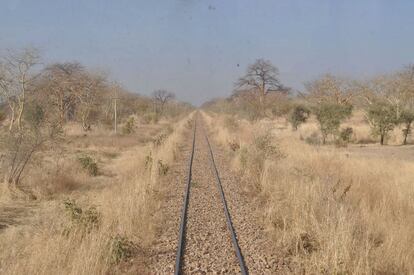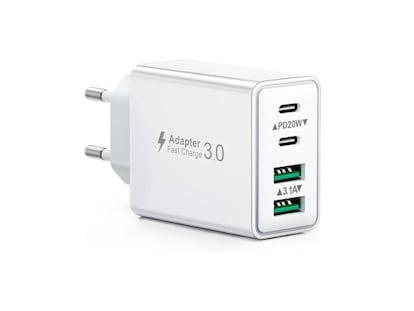Bamako-Dakar by rail (2)

The Dakar-Niger railway line links two of west Africa's capital cities and crosses 1233 kilometres of arid landscape filled with baobab trees and low grasses, scrub and bush. But deep in the ground of the border region of western Mali and eastern Senegal there are enormous riches of gold, phosphates and iron ore, one of the minerals used to make steel. With global demand for iron ore from booming nations such as India, China and Brazil, still high despite the world economic slow-down, these untapped resources hold great value and the governments of Senegal and Mali are keen to get these goods to the outside world.
The only thing linking the rich lands of this border region and the outside world is a train line which was laid more than one hundred years ago and, considering the wear on a piece of transport infrastructure such as this, should have already been replaced at least once. But lack of investment and complications brought about by the fact that the rail runs between two different countries with two different legal systems, economic agendas and socio-political situations, means that the rail, as strategic and vital to the region's economy as it is, is the same one that was laid by French colonisers in the early 20th century. And because of this, the wagons carrying iron ore- a heavy mineral- from the mines to the port in Dakar, can only run one third full. “If the railway line was in a good state,” says Djibril Keita, secretary general of Transrail at his office in Bamako, “we could double exports”.
Between Kayes, in western Mali, and Tambacounda in eastern Senegal, are just 280 kilometres of largely flat, empty terrain. But derailments are so frequent (around one every three days in 2011) that Transrail can no longer run a passenger service between the two towns. I travelled with a delegation of Transrail officials and some mechanics in a small trolley-train in early 2012, and the journey between these two towns took us around 12 hours, with stops every few kilometres to bolt together pieces of track that had warped and broken, leaving gaps of sometimes of 30 centimetres. The sleepers are imprinted with the dates from when they were made, and as I walked along the track I could see dates going back as far as 1905. That the train can run at all on infrastructure as old as this seems nothing short of a miracle.
In Bamako I visited the massive Korofina rail workshops where the staff of Transrail take in old pieces of track, wagons which have derailed or broken down, or wheels which have worn thin from over-use, and repair them using melted-down bits of metal, massive and ancient machines, and plenty of engine grease. The men working in the soldering workshop showed me how they remove the wheels which are worn so thin that they can no longer stay on the rails, and fashion new ones. The machinery used on this section of the line is no longer available on the market so even the bolts used to keep the track together are made here. “This is do-it-yourself,” said the man showing me around the workshop. This word was used again and again as I rode the track, in the Presidential carriage and then the mechanic's trolley, the whole length of the line.
Digging deeper into the issue, there are all sorts of reasons why the Dakar-Niger railway is not getting the investment it needs. Just to improve the condition of the track, to make it safe for passengers, who can at the moment only ride from Bamako to Kayes, will require 177 billion CFA francs (€270 million). Actually replacing the track, which will allow both countries to fulfil export potential, will cost €1.2 billion. Neither country is willing to put in that kind of money, and donors can only lend to governments, while Transrail is owned by a complex mix of private and public investors.
There are also disagreements over the kind of rail which should be built: narrow gauge (the current kind of rail) is seen as 'colonial' whereas standard gauge is more 'modern'. However, much of west Africa's railway infrastructure is built in narrow gauge and trains can only run on one or the other. Replacing one section of track means replacing the whole lot.
While a company restructuring is ongoing in an attempt to allow donors to invest in the line, Senegal and now Mali have undergone government changes. Mali is currently in a political crisis that means its growth for 2012 will probably be negative, according to the Central Bank of West Africa States in June. In this climate, it seems that saving the Dakar-Niger railway line is even more far off than previously thought. Without it, Mali and Senegal's export potential, as well as the life that this railway line gives to those living along it, is in serious jeopardy.
Nota: Los textos de los autores se publican en su versión original, primero y, más tarde, traducidos al castellano (cuando encontramos el momento de hacerlo o la ayuda de algún espontáneo). Gracias.
Comentarios
Tu suscripción se está usando en otro dispositivo
¿Quieres añadir otro usuario a tu suscripción?
Si continúas leyendo en este dispositivo, no se podrá leer en el otro.
FlechaTu suscripción se está usando en otro dispositivo y solo puedes acceder a EL PAÍS desde un dispositivo a la vez.
Si quieres compartir tu cuenta, cambia tu suscripción a la modalidad Premium, así podrás añadir otro usuario. Cada uno accederá con su propia cuenta de email, lo que os permitirá personalizar vuestra experiencia en EL PAÍS.
¿Tienes una suscripción de empresa? Accede aquí para contratar más cuentas.
En el caso de no saber quién está usando tu cuenta, te recomendamos cambiar tu contraseña aquí.
Si decides continuar compartiendo tu cuenta, este mensaje se mostrará en tu dispositivo y en el de la otra persona que está usando tu cuenta de forma indefinida, afectando a tu experiencia de lectura. Puedes consultar aquí los términos y condiciones de la suscripción digital.
Archivado En
Últimas noticias
Internet y las redes sociales es lo que más influye en las opiniones políticas, según el CIS
Víctimas de la dana y entidades sociales exigen de nuevo el acta de diputado a Mazón: “No vamos a dejar pasar página”
Madrid deja en blanco el listado de recursos para víctimas de violencia sexual sin denuncia
El PSOE desvincula al exalcalde de Linares (Jaén) de una acusación de acoso sexual
Lo más visto
- Lotería de Navidad 2025 | 79432, el primer premio de la Lotería de Navidad
- Comprobar Lotería de Navidad 2025: consulta la pedrea con la lista de números premiados
- El Gobierno y Bildu acuerdan extender a 2026 la prohibición de desahuciar a personas vulnerables
- El PP de Almeida vota en contra de dedicarle a Robe Iniesta un centro juvenil porque antes quiere hablarlo con su familia
- Europa presiona a Ucrania para que contenga el éxodo de jóvenes hacia los países vecinos
































































